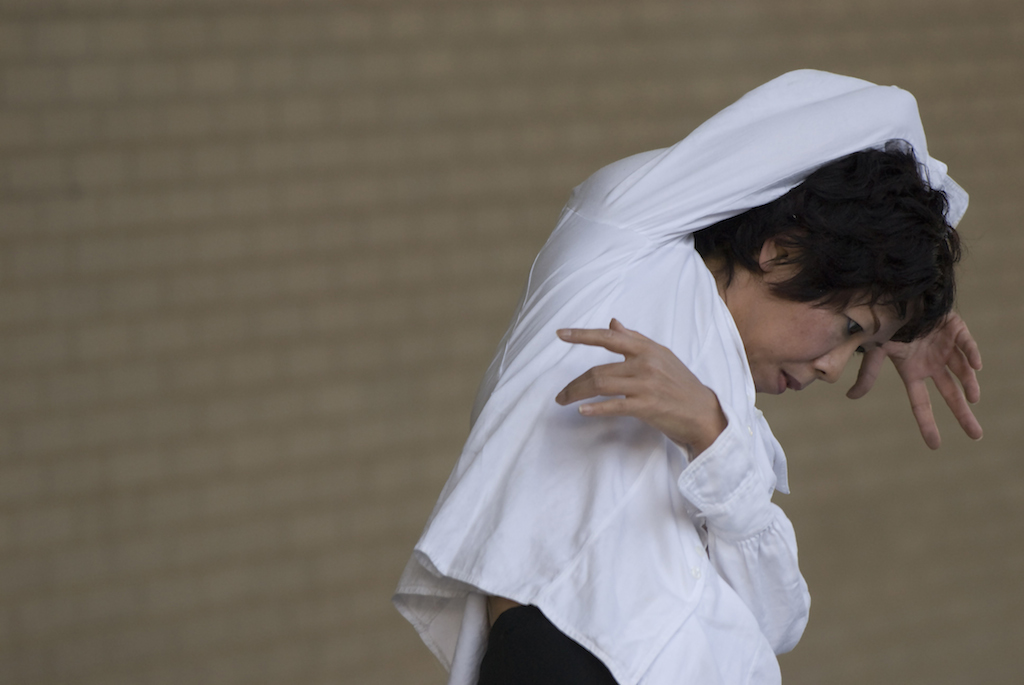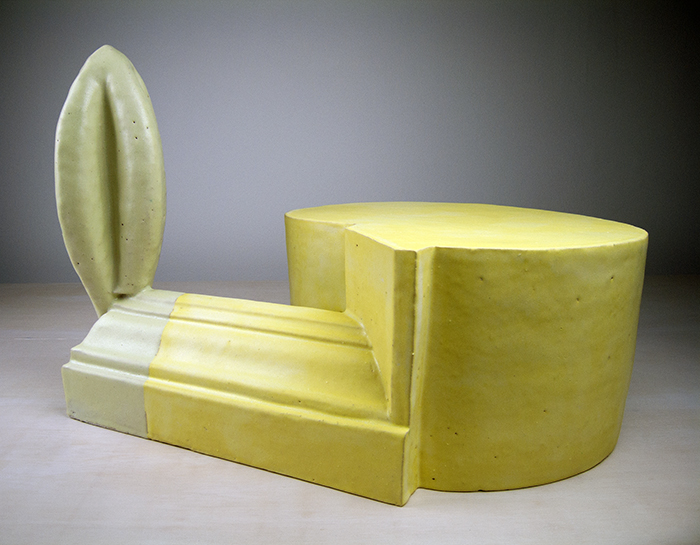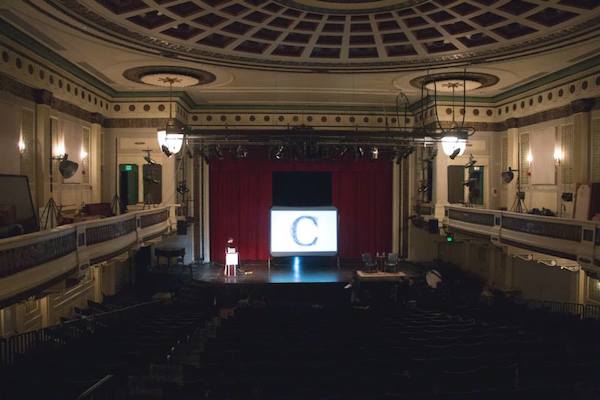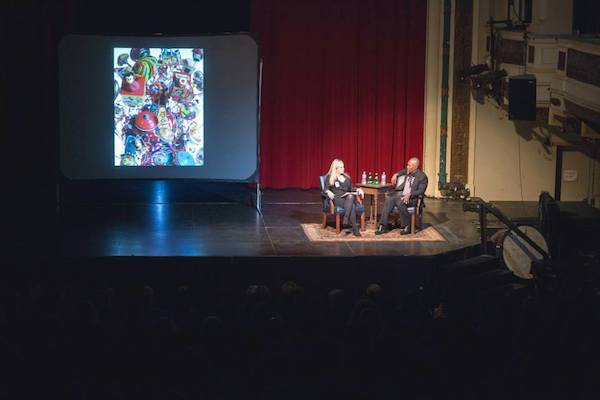A Review by Allison Gulick
The second in a series of thirteen artist talks titled CoHosts, sponsored by the Contemporary and physically accommodated at the Baltimore School for the Arts, was held on Tuesday, February 18. The series partners nationally renowned artists with local galleries and artist-run spaces in Baltimore. Speakers were selected by the cohosting organization when poised with the question, “Who is the one artist or art professional that you want The Contemporary to bring to Baltimore?”
The Pine Box Art Center, run by Vincent Valerio, which was originally located in Highlandtown but currently operating nomadically, selected Nick Cave as their desired artist. Cave, who is by no means a small fish in the art world, is an amazing catch for The Contemporary and helps exemplify their dedication to bringing the best to Baltimore.
The Baltimore School for the Arts is a beautiful setting and provided an unexpected sense of old-world grandeur. Exposed bulbs glowing over the entryway provided illumination to the damp and snowy sidewalk where bustling pedestrians greeted friends on their way into the performance space. Upon entering we were greeted by smiling interns and welcomed by the Director, Deana Haggag, and The Contemporary Board President, Terry Squyres.
After pleasantries were exchanged, visitors were directed to the reception room, a dance space during the day for BSA students, with a ballet bar and mirrored walls. The atmosphere was warm and friendly, with Baltimore’s art scene showing up in droves. From seasoned curators, to a slue of excited art students, to the artistically uninformed, and Nick Cave himself, there was a diverse range of attendees. This mix is something that frequently warms my heart at Baltimore events, where there is a strong sense of community and camaraderie. Even if you don’t know anyone, chances are you’ll make fast friends with someone bonding over your shared love of this quirky city, or the deliciousness of the smoked fish hors d’oeuvres provided by Clementine.
After the snacking and mingling, it was time for the main event. The stage at BSA is located in a historic great room. The ornate ceiling and woodwork provided the event with a sense of pomp and circumstance. The stage was set with an intimate table for two, a podium, and projection screen. Introductions were made, first by Haggag and then by Pinebox Art Center director Vincent Valerio, before the microphone was handed over to the moderator for the evening, Maiza Hixson, a Curator at the Delaware Center for Contemporary Art and frequent friend of Baltimore (she taught at Towson and performed illegal art weddings this past summer at Station North’s Koban).
 Nick Cave, Maiza Hixson, and Vincent Valerio
Nick Cave, Maiza Hixson, and Vincent Valerio
I was initially exposed to Cave’s work in an undergraduate art history course, and his work has long been enthralling for me. I’ve had the privilege of seeing his work in person more than once in solo shows like Let’s C (2012) at Philadelphia’s Fabric Workshop and Museum and his performative work, Heard (2013), which took place as a series of happenings in Grand Central Station. I’ve also seen pieces of his work hold their own in larger shows and collections, including the Thirty Americans (2011) at the Corcoran, and a piece in the collection of the Birmingham Museum of Art.
Nick Cave is predominately known for his soundsuits, which are large and incredibly intricate sculptures, generally humanoid in shape, but without distinct heads. Instead, a blade-like shape juts up from the shoulders, and audiences and academics have understood this as a myriad of different things, from a phallic symbol, a papal hat, a Klu Klux Klan hood, or alien life form. However you chose to interpret them, the suits are visually arresting and frequently overwhelming in material choice, intricacy, and detail of craftsmanship. They are made with everything and anything imaginable from crocheted blankets to sequins, plastic toys, buttons, old holiday decorations, iron flowers, and human hair. The list is endless.
Personally, I find the sound suits to be an interesting confluence of many different things. Rich with complex and layered meaning, the pieces inspire ideas about movement, the human body, nature, and the power of objects. In all of my experiences with the suits, as sculpture or in performance, I found Cave’s work to be extremely powerful, bordering on sacred. The work goes deep, with meaning stretching far below the surface glamour of the suit. And while I had admired Cave’s work, I had not read much substantive information about it, nor had I heard him speak. So I was particularly excited to hear this discussion, in Baltimore no less, which is in many ways is analogous to a sound suit with it many facets, layers, and multiple meanings.
For this reason, I approached Tuesday evening much like a child approaches an upcoming birthday, with a lot of expectations about the party, the presents, and the cake. And instead of the art-nerd dream of in-depth and intense meaning which was sure to be discussed by Cave, within this metaphor all I got was cake on my face, and no one came to my party, and all my presents were lumps of coal disguised as fool’s gold. I was rather disappointed and upset, to say the least. The seriousness that I had once believed inhabited Cave’s work was marred by the flippant and superficial answers he provided when he wasn’t completely evading the questions posed to him. And while Hixson attempted asked interesting questions, I felt a buzzing nervous energy between herself and one of her “personal heroes” that made it apparent that neither was at ease with the other.
As the discussion continued things only went downhill with Hixson asking questions about Cave’s nonexistent attempts at community engagement and his grueling testing process for finding art minions, I mean interns, for his studio. As the conversation haltingly and painfully continued I became more disillusioned with my once beloved artist, as he spoke about jet-setting, his commercial endeavors, and how he can no longer work with students on his film projects after producing the highest quality work with the United Colors of Benetton.
Although I left the event feeling disheartened, continued conversations with friends and colleagues led me to some redemptive questions that the lecture had forced me to ask myself. What does it mean for an artist to be successful? And how do people within and outside the art world contribute to the pressure that is placed on artists to be commercially successful, charismatic public speakers, community engagers and revitalizers? Not to mention, the mass quantities of meticulously crafted and conceptually flawless aesthetic masterpieces we expect them to churn out for a reasonable price.
Considering these factors did not do much to shift my perception of the evening’s discussion, or my disappointment in Cave’s arrogant answers that reflect a celebrity far removed from recognizing the importance of the audience in receiving the artist’s message. And while this talk may not have provided its audience with the deep and meaningful conversation we were anticipating, I think it did highlight the overarching intention of the lecture series. The CoHost series as a whole is taking calculated risks and providing Baltimoreans with opportunities to see and hear from artists that they would otherwise be denied. And while the series is still young, I’d consider it successful thus far because of its ability to reach the audience on a local level, exposing us to nationally renowned artists while also raising awareness of the great art spaces that are already here in Baltimore.
* Author Allison Gulick currently works for the Office of Community Engagement at the Maryland Institute College of Art (MICA). She has her MFA in Curatorial Practice from MICA and a BA in Art History from the University of North Carolina at Asheville. Her previous curatorial work includes the exhibitions: Fan Brush: An Exhibition of Work by Matt Muirhead, Reloading the Canon: African Traditions in Contemporary Art; Invited: Celebration Station; Live and In Person: Globe Posters at MICA and The Meyerhoff Symphony Hall; and La Riqueza Del Pueblo: The Richness of the People. Allison has an addiction to coffee, chocolate, books, and British period dramas. She has a poker face that would put Lady Gaga to shame and in her spare time she rescues feral cats.
** Photos by Olivia Obineme courtesy of The Contemporary









